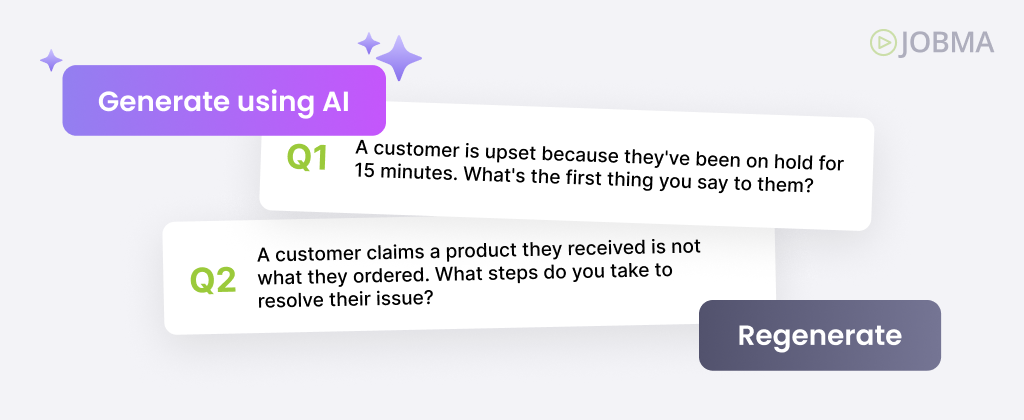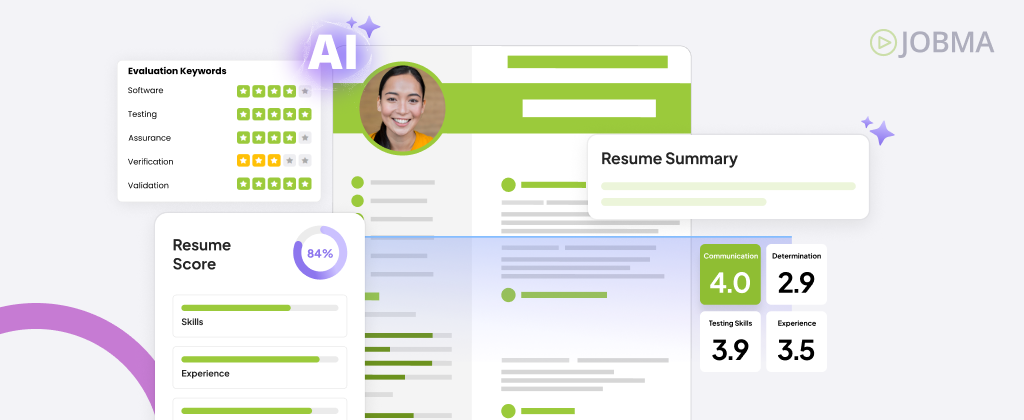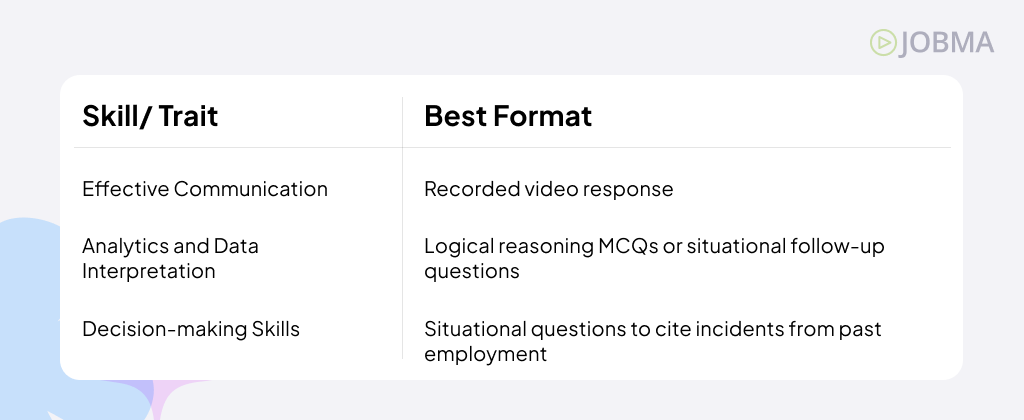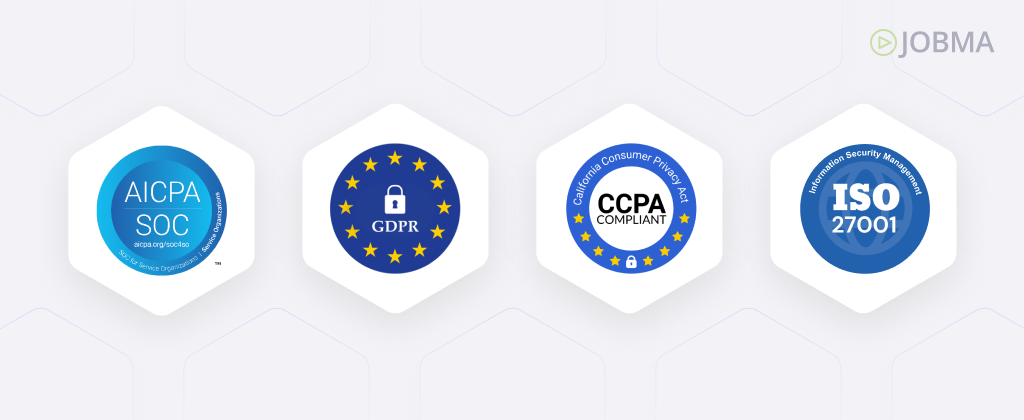How to Build Effective Pre-Employment Assessments with AI
Hiring has become less about filtering resumes and more about making high-quality decisions at speed and scale. In an environment where talent is a key differentiator, organizations can no longer afford fragmented hiring workflows or inconsistent evaluations. The need for faster, more precise, and repeatable decision-making is pushing recruitment teams to evolve beyond traditional screening methods.
AI-powered assessments help make early hiring decisions faster, fairer, and more consistent. Instead of relying only on resumes or gut instinct, these tools evaluate candidates on real job-relevant qualities, like how they solve problems, communicate, adapt, or think under pressure. They’re designed to highlight potential, not just experience. As a ZenBusiness study found, while they don’t replace human judgment, they give your team better data to make more confident, informed choices.

In this blog, we’ll explore how AI-based pre-employment assessments work, what they bring to modern hiring strategies, and how to implement them effectively in your organization, whether you’re scaling a team or refining your evaluation process.
What Are AI-Driven Pre-Employment Assessments?
AI-driven pre-employment assessments are structured evaluation methods that use artificial intelligence to evaluate candidates based on job-relevant traits, skills, and competencies. These assessments help screen candidates and simulate real-world work scenarios to reveal how a candidate thinks, solves problems, and applies their skills in context. Instead of relying solely on past work experience, AI evaluates how well someone is likely to perform in the role they’re applying for.
Most common formats of AI-powered assessments include:
- Video-based hiring assessments: Candidates answer structured scenario-based questions on camera, offering insights into their communication style, confidence, and clarity.
- Live situational assessments: Candidates interact with an AI agent to answer role-specific scenario questions and follow-up questions meant to gauge decision-making, subject knowledge, and practical thinking. Candidates also respond to statements or prompts that reveal work preferences, personality traits, and team compatibility.
- Technical tasks or simulations: These tasks test the functional and technical know-how in a job-relevant context, which is useful for roles in engineering, finance, or operations. For example, while hiring for a Software Engineer role that requires proficiency in the Python language, the candidate may be prompted to solve a test stub for Python.
When combined, these formats give you a holistic view of a candidate’s capabilities, far more objective than what you would get from a resume or a phone screen.
This is how it works:
Candidates complete the assessment from anywhere at any time. The AI acts as an agent and analyzes responses for communication skills, problem-solving ability, learning agility, and behavioral tendencies, based on the criteria you’ve set for the role.

Rather than having a recruiter present during the interview, AI agent acts as an intelligent assistant, automating repetitive initial screenings and resume shortlisting processes, while filtering top candidates based on their performance. It enables hiring teams to identify high-potential candidates faster, especially in high-volume recruiting scenarios where manual evaluations may not be as scalable.
For example, instead of spending hours manually reviewing applications for a customer service position, recruiters can have candidates respond to a set of structured questions, and the AI analyzes responses for skills relevant to customer-service roles, like tone, clarity, and communication skills. This innovative solution can be efficiently built with the help of an AI development company. A sales position may require confidence and adaptability, while a finance role may prioritize analytical thinking and attention to detail.
These traits are not easily captured through resumes alone, making AI-based assessments an invaluable tool for deeper candidate profiling.
Why Use AI in Pre-Employment Assessments?
AI-powered assessments improve early-stage hiring by analyzing how candidates respond to real-world scenarios, like timed video questions, problem-solving tasks, or behavioral prompts. Instead of just scanning resumes, these tools evaluate traits like communication, adaptability, and critical thinking using structured, role-specific scoring. This enables organizations to hire at scale without compromising on candidate quality.
- Faster Screening: AI tools help evaluate 10 candidates in the time it would take to evaluate 1-2 candidates using traditional over-the-call screening. This is a dramatic reduction in the time spent on initial screenings. This is particularly useful for roles with high applicant volumes, such as customer service, sales, or graduate hiring programs.
- Standardized Hiring: With AI, every candidate is evaluated using the same parameters, metrics, and scoring logic. This ensures that every applicant applying for the same job, whether it’s an entry-level role or a leadership position, is evaluated equally based on prespecified job competencies.
- Improved Candidate Experience: AI-driven assessments streamline and improve the candidate journey by automating early-stage evaluations. Because these assessments are often asynchronous, such as recorded video responses, online tests, or scenario-based simulations, candidates can participate on their own time and from any device. This increases accessibility and puts candidates in control of their experience.
- Fair Hiring: AI algorithms are programmed to focus on role-specific traits and remove factors that can introduce unconscious bias. For example, Jobma’s scoring model does not consider a candidate’s name, gender, or religious background, only their response content.
- Scalability: Whether you’re screening 50 or 5,000 candidates, AI tools scale effortlessly. You don’t need to expand your recruiting team, just set up your assessments once and let the system do the heavy lifting.
Example: For a tech company hiring junior developers, an AI-driven assessment might include a short coding test, a situational judgment question, and a communication prompt. Based on the responses, the AI filters out low-scoring candidates and recommends top performers for further technical interviews, cutting down recruiter workload by 70%. You can take an AI development company’s help to build transparent and responsible AI hiring tools designed to provide clear insights into decision-making processes, actively reduce bias, and ensure data privacy compliance.
How to Implement AI Assessments into Initial Screening
AI-powered assessments are most effective when integrated at the front end of your hiring strategy, serving as a structured, consistent method to screen and shortlist candidates who best meet the job’s core requirements. Here’s how to implement them intentionally:
Step 1: Identify Your Hiring Goals
Despite AI’s transformational potential, many organizations stumble early in their supply chain journeys due to a handful of persistent obstacles. The biggest hurdle is data quality and consistency. When formats differ, fields are missing, or data sits in isolated silos, even the smartest AI can’t work effectively.
1. Ensuring Data Quality & Unified Sources
Before introducing AI into your screening process, get clear on what you’re solving for. It’s not just about using AI, it’s about aligning AI with specific hiring goals.
Do you want to reduce time-to-hire?
Do you want to improve candidate quality?
Is the goal to standardize hiring across departments?
How to do it:
- Identify common challenges in your early funnel. Talk to recruiters and hiring managers. Are they overwhelmed by resume volume? Struggling to assess soft skills objectively? Losing time to misaligned interviews? Write these pain points down.
Example: “We get too many resumes for customer-facing roles, but can’t quickly evaluate communication skills upfront.” - Review 2 to 3 recent hires or failed interviews. What signals would’ve helped you spot the right (or wrong) candidates sooner? Think in terms of skills, behaviors, or traits that are currently hard to screen for at scale.
- Translate those insights into measurable goals. Your goals may look like this:
- “Reduce time spent reviewing resumes by 50%”
- “Shortlist candidates with strong critical thinking for technical roles.”
- “Get a consistent view of soft skills before interviews.”
This becomes your foundation for deciding how to use AI later.
Step 2: Select the Right AI Platform
Once you’ve defined what you want to improve in your early screening stage, the next step is to select an AI platform that directly supports that goal. Partnering with AI Development services can help you ensure the platform you choose is tailored to meet your hiring needs. The right tool should streamline your shortlisting process, not force you to change your entire hiring flow. Here’s how to evaluate platforms:
- Start with your top screening goal from Step 1. For example: “We need a fast way to evaluate communication skills before interviews.” Use this goal as your decision filter when exploring tools.
- Shortlist platforms based on core features. Look for tools that offer assessments designed specifically for early-stage screening. These may include:
- One-way video interviews with automated scoring
- Written response evaluations
- Role-specific cognitive or behavioral assessments
- Situational judgment simulations
- Check for compatibility with your existing HR tech-stack. Ensure the AI interviewing management system can integrate with your current ATS, CRMs, calendar tools, onboarding systems, and recruiting workflow. Consider solutions like Microsoft Dynamics 365, and review their Dynamics 365 licensing options to ensure you choose the right plan for your organization. Verify if they comply with global data privacy regulations like GDPR and CCPA. This helps avoid duplicating tasks or managing candidate data in two places. Partnering with a trusted Dynamics 365 partner ensures a smoother setup process and better alignment with your business goals.
Actionable Tip: Create a checklist with 3 columns:
- Must-have features: Directly tied to your goal (e.g., evaluates communication, has AI scoring capabilities, and allows automating shortlisting candidates).
- Nice-to-have features: Features that could improve usability (e.g., multi-device compatibility and branding options).
- Deal-breaking features: Features that help you pick pace and back decisions with insights (e.g., comprehensive reports, sharing and downloading interviews for collaborative hiring).
For example, Jobma offers customizable pre-employment assessments, ranging from subject knowledge tests to situational interviews and even role-specific coding challenges, has integrated AI scoring, and follows robust data protection protocols.

Step 3: Customize Your Assessments
Once you’ve selected an AI assessment platform, you can use the ready-to-use role-specific assessments or customize your own. The goal is to screen for what matters in each role, not just check a box. Thoughtfully curating thoughtful assessments ensures you’re evaluating candidates based on the right mix of skills, traits, and role-specific expectations.
This is how you can tailor AI assessments:
- Start with the in-depth job description. Talk to the hiring manager and ask:
- What does this person need to be good at from day one?
- What skill do we usually miss when screening for this role?
Example: For a marketing associate role, the manager might say, “They need to communicate effectively, understand campaign metrics, and be mindful of key marketing strategies in their industry.”
- Map those answers to assessment types. Based on the insights, choose the best-fit assessment format:

- Keep assessments short and relevant. Focus on testing 2-3 high-impact skills per role. Don’t overload candidates with long tests that could risk losing the candidate’s engagement. Limit total assessment time to 10-15 minutes, especially for entry-level or mid-level roles.
Step 4: Train Your Team
To unlock the full value of AI-powered assessments, your hiring team needs more than access, they need clarity that can be shared through extensive training and effective communication. Structured training ensures your team understands how the assessments work, how to interpret results, and how to use those insights confidently in the screening and interview process.
1. Start with a live walkthrough to give your recruiters and hiring managers a guided session on how to use the AI assessments platform. Walk them through:
- How assessments can be sent to the applicants.
- The criteria to be used to judge a candidate’s performance.
- The desired score to move a candidate forward in the hiring process.
Share an example of an AI-based pre-employment assessment for a sales role and a real completed candidate interview. Show the candidate’s AI scorecard (e.g., Communication: 9/10, Adaptability: 6/10, Problem-Solving: 8/10). Explain that a higher rating may indicate strong skills.
2. Tie training to real-life decisions and focus on how your team can use the results to:
- Prioritize candidates for live interviews.
- Ask follow-up questions that help gather more information about the skills highlighted in the pre-employment assessment.
- Spot potential for improvement and learning that can help the candidate excel in your organization, even if the resume is weak.
For example, if two candidates score similarly on technical skills but one scores significantly higher in collaboration, the hiring manager might decide to move that candidate to the next round sooner for a leadership role, like Product Owner.
3. Schedule brief refreshers every quarter or when you update your assessments, or to touch base with your team about any new roadblocks or challenges they’re facing. Use this time to review what’s working well, address questions from recruiters, and share any new updates and features in the AI platform in use.
For example, if your AI platform updates how it calculates cultural fit, review the new scoring logic and run a 20-minute team sync to align on how to use it during evaluations.
Step 5: Continuously Monitor and Improve
Implementing AI in pre-employment screening isn’t a one-time setup, it’s an ongoing process. To get consistent results, you need to check what’s working, what’s not, and where adjustments can help. Monitoring helps ensure your assessments stay relevant, fair, and effective as hiring needs evolve. Perhaps your assessments need to focus more on cultural fit or adapt to new role requirements.
Track simple, meaningful 2-3 hiring metrics that directly tie to hiring outcomes, including:
- Assessment Completion Rate: This helps track whether candidates are finishing the assessment or dropping off midway. If completion is low, consider shortening the test or adjusting the format.
- Interview Conversion Rate: This helps ascertain the number of candidates who move to the next stage after getting shortlisted. A high match rate means your assessments are identifying the right people. A low rate may mean your test needs to be upgraded.
- Time to Shortlist: This is the time it takes for the candidate to get from application to a shortlisted pool. If this number has gone down, AI is helping your team move faster.
Review the candidate and recruiter feedback you receive for your platform and assessments. After each role is closed, ask recruiters, “Did the AI scores match your interview experience?” and if any strong candidates were missed. Collect feedback from candidates via email sequence software or survey with questions like “Did the assessment feel clear and fair?” and “Were the assessment questions relevant to the job?”. This helps you spot blind spots, like if a question feels confusing or doesn’t reflect the actual role.
Once you have feedback, improve the screening experience and revisit each assessment every quarter, or whenever you open the role again. Remove or reword a question that candidates found unclear, add a new video prompt for a critical skill the team felt was missing, or adjust the scoring weight if one competency is over- or under-emphasized.
Addressing Common Concerns about AI in Hiring
While AI-powered assessments have proven to improve hiring outcomes, HR leaders and recruiters still have valid questions about how these tools work, what risks they pose, and how to use them responsibly. Let’s address the most common concerns and how to manage them effectively.
1. Transparency in Decision-Making
One of the biggest challenges with AI in hiring can be a lack of clarity around how decisions are made. A lack of transparency can damage both hiring decisions and candidate experience and pose compliance risks.
To address this, your tool should clearly show why a candidate scored high or low. Go for AI platforms that show score breakdowns (e.g., 8/10 in communication, 6/10 in logical reasoning) and highlight what specific responses triggered those results. Also, maintain transparency with your candidates by sharing how AI will be used in the hiring process, sharing disclosures about their data being collected (if any), and how to effectively interact with AI. This way, recruiters can trust it and be confident in their decision, and candidates can get comfortable and perform their best during assessments.
2. AI Bias Reduction
AI models often learn patterns from existing hiring data, which might already be biased. For example, if a company historically hired more extroverted males for leadership roles, the AI may start scoring similar profiles higher without realizing the bias. Left unchecked, this can lead to the exclusion of diverse talent or reinforce stereotypes, which can betray the ethical considerations for using AI in hiring.
To address it, make sure your AI platform doesn’t rely solely on your past hiring history. Activate anonymizing information such as name, gender, and school names to ensure only role-relevant traits are evaluated. At least once a quarter, compare success rates (shortlisted, rejected, assessed) across different candidate demographics, such as gender, ethnicity, or age group.
3. Candidate Experience and Human Connection
AI tools speed up hiring, but if candidates feel ignored or misunderstood, they may drop off or develop a negative impression of your company. This is especially critical in early-stage or high-volume hiring, where candidates may have their AI as their first point of interaction in the application process. The challenge is balancing automation with authenticity.
To address this, let candidates know they’ll complete an AI-powered assessment and explain how it works. When candidates understand what’s being evaluated and why, their trust in the process increases. Let AI handle the initial screening and recommend scoring, while you invest more time to build candidate relationships and improve interview quality. For example, platforms like Humanize AI Text can help make AI-generated communications sound more natural and engaging, improving candidate experience and trust.
4. Data Privacy and Consent
AI-driven assessments often collect sensitive candidate information, video recordings, voice data, behavioral signals, and more. If candidates aren’t confident that their data is being handled securely and ethically, it can erode trust and pose compliance risks under laws like GDPR (General Data Protection Regulation) or CCPA (California Consumer Privacy Act).

To address this, choose a platform that is GDPR/CCPA-compliant and offers features like data encryption, limited access controls, and role-based permissions. Ask how long data is stored, who has access, and how deletion requests are handled. Let candidates know why you’re collecting the data, how long it will be stored, and who will have access to it. Consent should be explicit, not buried in a generic privacy policy.
Embracing the Future of Recruitment
Pre-employment assessments powered by AI aren’t just another tech upgrade, they’re a practical response to the challenges hiring teams face today – high volumes, limited time, and pressure to get decisions right.
Top-performing organizations now see AI as foundational to hiring efficiency. These tools give recruiters more than just resume data. They provide deeper insights into how candidates think, communicate, and solve problems, all based on consistent, structured evaluations. This means fewer missed opportunities and more confident shortlisting, even in high-volume hiring scenarios. Used right, AI doesn’t replace the human element, it supports it and handles the repetitive, early-stage screening, so your team can focus on what matters: engaging the right talent.
AI-powered hiring platforms enable this transformation without overhauling your existing workflows. It brings together structured assessments, AI insights, and a recruiter-friendly interface that makes smart hiring simple and scalable.
If your goal is to build a faster, fairer, and more effective hiring process, now’s the time to put AI-powered assessments to work.




